The Great Pumpkin | So Much More Than Just a Squash
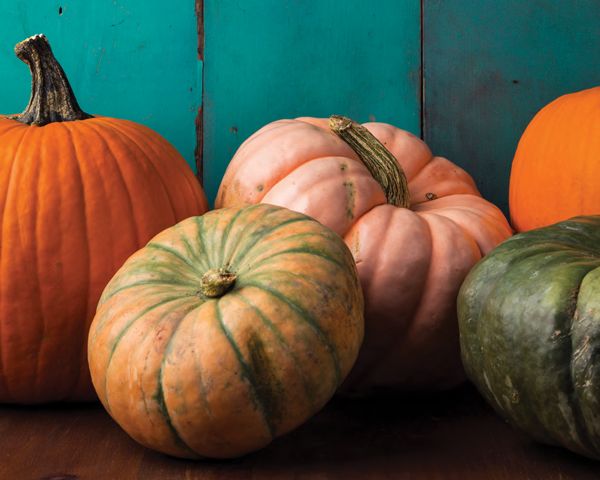
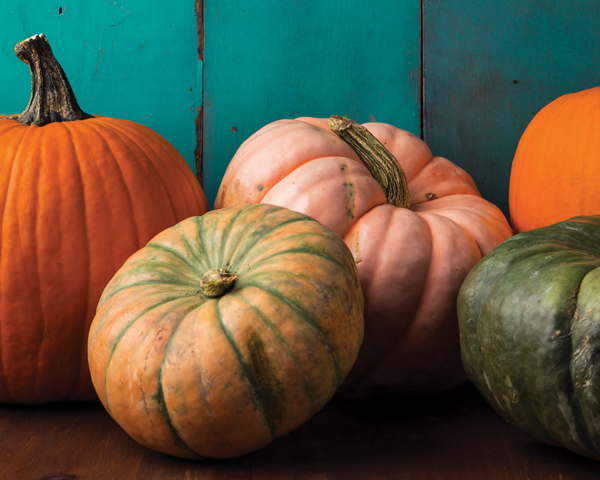
Pumpkins, squash, and gourds are ubiquitous this time of year. Available in a wide array of shapes, sizes, colors and textures, their thick skins allow them to rest comfortably for months in cooler temperatures while the interior flesh stays intact. Part of the large and diverse Cucurbitaceae family, which includes melons and cucumbers, these plants are known to be prolific producers, with fast-growing climbing vines, twining tendrils and little to no effort required on the part of the gardener than providing a trellis or enough garden space for the plants to sprawl with abandon.
Squash is believed to be native to the Western Hemisphere, where it was introduced to European settlers by Native Americans and quickly became a reliable crop and essential food source for the settlers. The seeds traveled to Europe and back again, as different types were developed for their looks, flavor, ease of growing and ability to withstand more extended storage. Today there are hundreds of varieties, some better known than others.
Technically, the term ‘pumpkin’ has no biological meaning, since pumpkins are classified not as gourds but as large varieties of squash. All squash are edible while not all gourds are. Ornamental gourds have been grown for centuries for their hard shells, valued for use as utensils, cups, water carriers, pipes, musical instruments and more. Planted in the spring and early summer, the thick skin of edible gourds—what we often refer to as winter squash—needs a bit longer to mature. All but ornamental gourds can be harvested and eaten early; they are a more tender vegetable than their fully matured versions.
Generally, when one hears the word ‘pumpkin,’ one thinks of a large, orange, round winter squash that is mostly like a Connecticut field pumpkin. The fruit of these squash are not considered the most flavorful; these pumpkins are primarily grown for appearance, but they are edible. Some varieties that do offer that flavor we tend to think of as pumpkin, minus the spice, are the smaller sugar pumpkin, also known as a pie pumpkin. However, the north Georgia candy roaster squash was often featured in Appalachian Thanksgiving feasts at the turn of the twentieth century in the form of candy roaster pie.
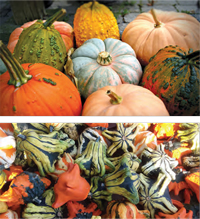 It is believed the tradition of pumpkin pie stems from a colonial-era practice of filling a hollowed-out winter squash with milk, spices and honey, baked in the ashes of the fireplace. The blend known as pumpkin spice is wildly popular and can be found in just about everything imaginable during the fall months. The mix of cinnamon, nutmeg, ginger, cloves and sometimes allspice is similar to what the Brits call mixed or pudding spice and is very complementary to fruits and other sweet foods.
It is believed the tradition of pumpkin pie stems from a colonial-era practice of filling a hollowed-out winter squash with milk, spices and honey, baked in the ashes of the fireplace. The blend known as pumpkin spice is wildly popular and can be found in just about everything imaginable during the fall months. The mix of cinnamon, nutmeg, ginger, cloves and sometimes allspice is similar to what the Brits call mixed or pudding spice and is very complementary to fruits and other sweet foods.
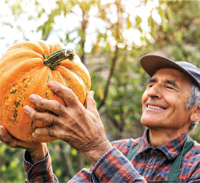 There is, however, far more to pumpkins than pie. First known as one of the Native American “Three Sisters” plants, it is one of three crops planted near each other in small mounds as companions. Corn, beans, and squash comprise the trio, with corn being the structure for the beans to climb while the sprawling squash plants cover the ground, squashing weeds and acting as a living mulch. The fruits of these plants weren’t just traditionally combined in the garden, but also in the pot that came to the table in a typical Native American stew, introduced to early settlers at Jamestown. In combination, these vegetables contain complex carbohydrates, essential fatty acids, and all nine essential amino acids, allowing Native American tribes—and early settlers—to thrive on a mostly plant-based diet. Winter squash, considered a nutrient-dense food, is rich in vitamin A, while also containing vitamin C, potassium, iron, and other healthy antioxidants and fiber. Even the seeds are beneficial to nutritional health.
There is, however, far more to pumpkins than pie. First known as one of the Native American “Three Sisters” plants, it is one of three crops planted near each other in small mounds as companions. Corn, beans, and squash comprise the trio, with corn being the structure for the beans to climb while the sprawling squash plants cover the ground, squashing weeds and acting as a living mulch. The fruits of these plants weren’t just traditionally combined in the garden, but also in the pot that came to the table in a typical Native American stew, introduced to early settlers at Jamestown. In combination, these vegetables contain complex carbohydrates, essential fatty acids, and all nine essential amino acids, allowing Native American tribes—and early settlers—to thrive on a mostly plant-based diet. Winter squash, considered a nutrient-dense food, is rich in vitamin A, while also containing vitamin C, potassium, iron, and other healthy antioxidants and fiber. Even the seeds are beneficial to nutritional health.
As squash found its way around the world, it adapted to native dishes, from variations on the original “Three Sisters” stew utilizing local beans, herbs and spices to African and Asian curries. It is an excellent substitute for yams and sweet potatoes and vice versa. In Brazil, winter squash, pumpkins or sweet potatoes are combined with butter or lima beans while African countries marry it with okra and peanuts. Depending on the variety’s size and shape, it is roasted or boiled then mashed and used in a variety of dishes: baked into bread or pies; used in soups or stews; tossed on pizza, into pasta or risotto. It can be folded into fancy versions of mac and cheese for extra flavor and nutrition, or it can stand alone, stuffed with any number of fillings—grains, meat, vegetables, cheese or all of the above—and roasted. It combines well with sweet flavorings—like pumpkin spice—or more savory ones, like rosemary and blue cheese, or sage and goat cheese.
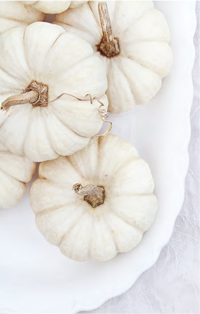 Among the more popular decorative pumpkins offered this time of year are the tan cheese pumpkins—their smooth tan to white skin makes them pop in a display, but did you know they keep for long periods and their deep orange flesh is sweet and highly edible? Turk’s turban pumpkins, so named because of the cap-like shape on top, were developed in France and are known for their ability to last during the winter months. The outer rind is quite woody but cut open and roasted, the flesh is delicious. The slate green skin of the sweet meat squash tastes better the longer it ages. While the hubbard squash is shaped more like a crookneck, its warty green exterior says otherwise; it’s yellow flesh is far mellower than butternut squash.
Among the more popular decorative pumpkins offered this time of year are the tan cheese pumpkins—their smooth tan to white skin makes them pop in a display, but did you know they keep for long periods and their deep orange flesh is sweet and highly edible? Turk’s turban pumpkins, so named because of the cap-like shape on top, were developed in France and are known for their ability to last during the winter months. The outer rind is quite woody but cut open and roasted, the flesh is delicious. The slate green skin of the sweet meat squash tastes better the longer it ages. While the hubbard squash is shaped more like a crookneck, its warty green exterior says otherwise; it’s yellow flesh is far mellower than butternut squash.
Sadly, the small decorative gourds often found this time of year are not edible, although the seeds can be harvested for growing your own crop should you so desire. Larger decorative gourds require drying time before being used; edible gourds, like luffa, need to be eaten before the fruits mature. Once matured, luffa can be dried and harvested for sponges.
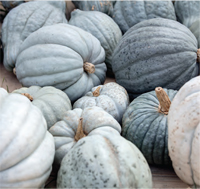 Whether you are hitting the local pumpkin patch for seasonal decorations or starting to plot next year’s garden, remember that pumpkins are edible and not just for pie. Select a variety of colors and shapes; once they have done their porch decorating duties, consider adding them to dinner. ✦
Whether you are hitting the local pumpkin patch for seasonal decorations or starting to plot next year’s garden, remember that pumpkins are edible and not just for pie. Select a variety of colors and shapes; once they have done their porch decorating duties, consider adding them to dinner. ✦
PLANTING YOUR PUMPKIN PATCH
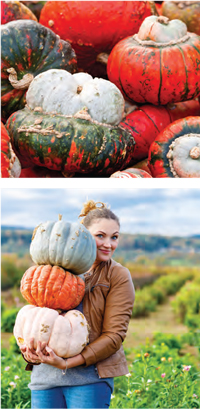 Pumpkins and gourds are incredibly easy to grow in your home garden—for larger, heavier fruits, you’ll want to be able to offer plenty of space for the plant to sprawl out. For smaller ones, a sturdy trellis should be sufficient.
Pumpkins and gourds are incredibly easy to grow in your home garden—for larger, heavier fruits, you’ll want to be able to offer plenty of space for the plant to sprawl out. For smaller ones, a sturdy trellis should be sufficient.- There are several online seed companies that offer heirloom pumpkins that grow well in our region. Among them: Johnny’s Select Seeds, Sustainable Seed Company, Baker Creek Heirloom Seeds or Virginia’s own Seed Saver’s Exchange, specializing in Southern Heirloom seeds.
- Pumpkins, gourds, and winter squashes all require warm days and warm nights to mature properly. Sow seeds directly in the garden with a soil temperature of at least 70 degrees, being certain all danger of frost has passed.
“Three Sisters” plants, Climbing Vines, Cucurbitaceae, cups, garden, gourds, luffa, musical instruments, Ornamental gourds, pipes, Pumpkins, squash, twining tendrils, utensils, water carriers, winter squash






